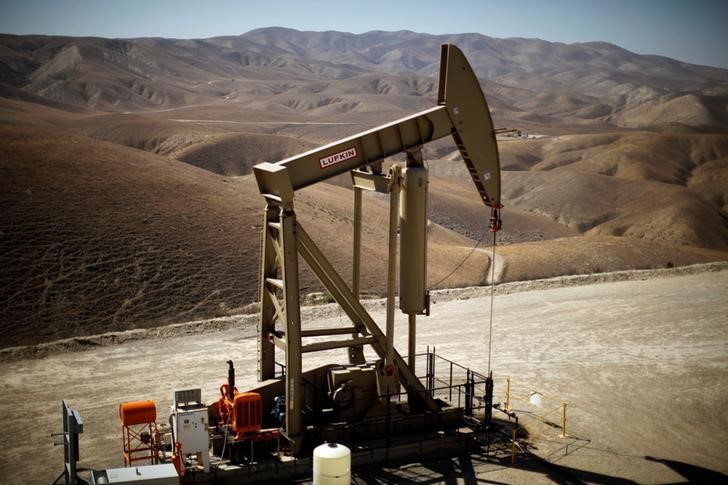 © Reuters. FILE PHOTO – A pumpjack brings oil to the surface in the Monterey Shale, California
© Reuters. FILE PHOTO – A pumpjack brings oil to the surface in the Monterey Shale, CaliforniaBy Henning Gloystein
SINGAPORE (Reuters) – Oil markets were stable on Friday as the Forties pipeline outage in the North Sea and the ongoing OPEC-led production cuts supported prices, while rising output from the United States kept crude from rising further.
U.S. West Texas Intermediate (WTI) crude futures were at $57.13 a barrel at 0119 GMT, up 9 cents from their last settlement.
Brent crude futures, the international benchmark for oil prices, were at $63.35 a barrel, up 4 cents from their last close.
Traders said markets were overall well supported by efforts led by Organization of the Petroleum Exporting Countries (OPEC) and Russia to withhold supply to prop up prices.
The ongoing outage of the Forties pipeline, which carries North Sea oil to Britain, was also buoying crude prices, traders said, as inventories around the world were gradually being drawn down.
“Inventory drawdowns keep us confident that longer term market fundamentals are headed in the right direction and supply and demand imbalances will pull oil back up to marginal cost,” Bernstein Research said.
“We forecast Brent averaging $56 per barrel in 2018 following OPEC’s cut extension, recovering to $60 per barrel in 2019,” it added.
Goldman Sachs (NYSE:) said that market conditions allowed the major oil companies, which it referred as Big Oil, to enter “a positive earnings-revision cycle” and that “this should allow Big Oil to re-employ capital at double-digit returns”.
The U.S. bank said that the improved market conditions were a result of a higher price outlook of an expected annual average of $62, $60, and $55 per barrel for 2018, 2019 and 2020 respectively.
The companies usually associated with ‘Big Oil’ are BP (LON:), Royal Dutch Shell (LON:), ExxonMobil (NYSE:), Chevron (NYSE:) and Total.
Undermining OPEC’s efforts to tighten the market is U.S. oil production, which has soared by 16 percent since mid-2016 to 9.78 million barrels per day (bpd), close to levels of top producers Russia and Saudi Arabia.
Rising U.S. supply, driven largely by shale drilling, will likely move oil markets into a supply surplus in the first half of 2018, the International Energy Agency (IEA) said on Thursday.
“Total supply growth could exceed demand growth: indeed, in the first half the surplus could be 200,000 barrels per day (bpd) before reverting to a deficit of about 200,000 bpd in the second half, leaving 2018 as a whole showing a closely balanced market,” the Paris-based IEA said in its monthly oil market report.
Fusion Media or anyone involved with Fusion Media will not accept any liability for loss or damage as a result of reliance on the information including data, quotes, charts and buy/sell signals contained within this website. Please be fully informed regarding the risks and costs associated with trading the financial markets, it is one of the riskiest investment forms possible.
Source: Investing.com




























